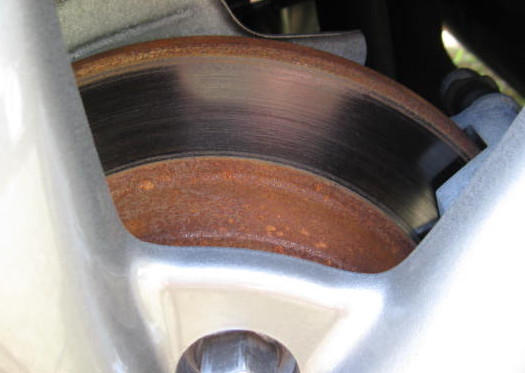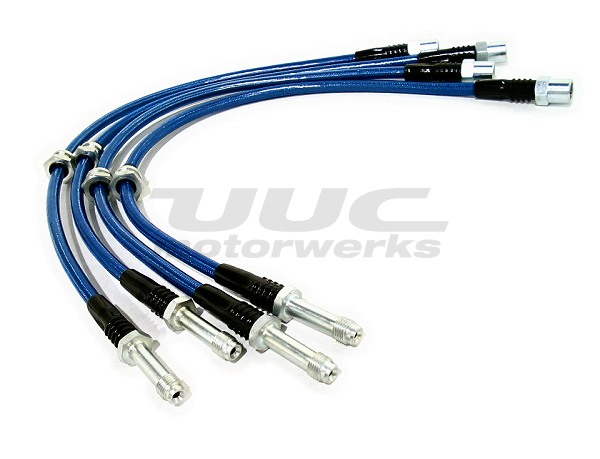
Ultimate
performance for
your
BMW
   
BRAKE PARTS 101

EVERYTHING
YOU EVER NEEDED TO KNOW ABOUT BRAKE ROTORS, BRAKE LINES, and BRAKE PADS.
| OVERVIEW |
|
Brake
parts are for much more than simply slowing down the car. The
control of deceleration forces is a critical part of performance
driving and safety, no matter if on the street, track, or competition
course. Brakes control the chassis, meaning that appliction
of braking forces affect the weight transfer and balance, which in turn
affect how and what the suspension and tires do to position the car on
the road.
Weight transfer changes the forces on the tires; the very simple
example is skidding (or engaging ABS), which signifies that the tires
are being asked to do more than they can. While this can lead
to a loss of control on the street, in can lead to even more dangerous
control failure in the higher speed and quicker-changing situations on
the track. Maintaining ideal chassis control
through braking is not only a function of the driver's input, but the
design and type of braking components on the car.
|
| ROTORS |
|
For
simplicity in this explanation, we will address the standard iron brake
rotor and leave carbon and ceramic rotors aside.
MATERIALS
The specific metal used for brake rotors is nothing all that fancy, but
the details and manufacturing are the key components to quality and
performance. All iron brake rotors are cast from a
formulation called "gray iron". This chemical composition of
this iron has a specific carbon and silicon content which causes it to
have a graphitic microstructure for very high stiffness, high heat
capacity, and most importantly high thermal conductivity which allows
for rapid cooling.
Although gray iron would seem to be a simple alloy, the fact is that
the methodology and care used in the alloying and casting process are
what separates a good quality rotor that provides long service life,
smooth operation, and no failures from a cheaply-made product that may
wear faster, cause vibration and shimmy, and even crack or break under
hard use.
DESIGN
Aside from being just a plain iron
disk, there are various surface
treatments done with varying results.
The most common and most effective treatment is slotting, where
grooves are machined into the surface of the rotor. Slotting
has multiple purposes. First, as a safety feature in
street-driven cars; when driving in rain or running through deep
puddles, a rotor that gets wet will instantly transform that water into
steam which can exert enough pressure from expansion to push the pad
off of the rotor surface. The slots act as a pathway to release that
steam quickly, eliminated the pad float problem.
The second
purpose is similar, but more of a feature for track or race use; when
brake pads get hot enough, they can "off-gas", which is to release a
gas as a product of extreme heat. The off-gas effect is
similar to the steam effect earlier, lifting the pad from the surface
of the rotor. The slots perform the same function and give
the gas a quick escape path, allowing the pads to remain in contact.
Thirdly, a combination of safety and good maintenance, is
that the slots act as a visual wear indicator to show how much rotor
life is left. With modern cars, including all BMWs, the
allowable wear depth is often approximately 1mm or just over.
With the slots machined to the maximum wear depth, a very
quick visual inspection shows how much rotor life is left.
With UUC rotors that are slotted to the minimum wear
thickness, it is simple to tell the rotor is worn out when the slots
are worn away. |
Slotted rotors: |
 |
| UUC
slotted rotor. |
 |
| Drilled
rotors: |
The second most common
treatment is drilling,
where holes are drilled through the rotor all across the surface.
Unfortunately, the applications where this is most commonly
usedare the applications that most likely should not be using it.
Drilling a rotor serves only one legitimate purpose, to
remove weight from the rotor. True race rotors that are
lightened in this way have large holes, almost big enough to put a
pencil through. These race applications are usually short
duration (such as auto-x) as the drilled weight reduction reduces the
rotors cooling ability. For faster track use, the reduced
cooling capacity is substantial and certainly not worth the weight
reduction.
For street cars getting drilled rotors just for "racy looks", the fact
is that it's a braking performance downgrade. The reduction
in cooling capacity is due to
multiple factors, each one of them substantial. First, the
way that a rotor cools itself is through the internal venting, viewable
from the rotor's edge. The internal vanes and air passages
act as a centripetal air pump, drawing air in at the center and pumping
it through to vent at the edge, cooling the rotor internally.
With holes drilled all through the rotor, there is no pumping
action whatsoever and therefore no cooling effect.
The second
major issue is the weakening of the rotor disk itself caused by
drilling holes; the introduction of this perforation is similar in
effect to what is seen with the perforation line between sheets of
household paper towels, a point where the basic material breaks apart
easily. Initial stages of this are visible on many cars,
exhibited as a spiderwebbibng of small cracks between the holes.
Catastrophic rotor failure is definitely not a fun thing to experience
in any situation.
Between these two problems, excessive
heating and structural weakening, drilling is a treatment that should
be avoided.
|
 |
| Race-only
rotor with lightening holes. |
 |
| Drilled
rotor showing stress cracks. |
COATING
Gray iron, like any standard iron,
rusts easily. This can
easily be seen on any car after a rainy day, rusty spots on the rotor
surface where it got wet. Many original equipment
applications with an uncoated rotor will show a heavily rusted central
part of the rotor around the hub, the area that is not contacted by the
brake pads. With how enthusiasts care for their car's
appearance, this rusty central ring is ugly and unsightly.
To
prevent this, a quality rotor will have an anti-corrosive protective
coating. The least expensive way to do this is with a zinc
(silver color) or cadmium (gold color) plating process.
Typically these plating methods work decently, but may not
last the full lifespan of the rotor such that rust will eventually
appear in that central area.
A better coating that does last
the lifetime of the rotor is black e-coating (electro-coating, a
process that permanently embeds the black color into the iron), which
also makes the
rotor center blend in better with any color of wheel. |
Black
electro-coating in center: |
 |
| Unsightly rust in
the center and on edges of typical uncoated rotor: |
 |
UUC
rotors are made from a highly refined gray iron alloy to maximize
cooling capabilities and strength as well as provide maximum service
life. All UUC
DirectFit rotors feature black e-coating and are available with either
a plain surface or slotted surface.
See
all UUC BMW DirectFit rotor applications, [
CLICK HERE ]
|
|
| BRAKE
LINES |
|
| Stainless
steel braided brake lines with protective outer layer: |
The brake calipers are
operated by high pressure hydraulic fluid. The
fluid is pumped into the caliper from the brake master cylinder
(actuated by the driver's foot on the brake pedal), which causes
pistons inside the caliper to squeeze the pads against the
rotor. This
system operates under a very high pressure, up to 1200psi.
For an enthusiast, precise and accurate control of brake application is
critical for chassis control. The brake lines are the
connection
between what happens at the pedal and what happens at the brake
caliper. This often-overlooked part of the braking system can
be
easily and affordably "tuned up" with a performance brake line,
designed as a teflon tube core, wrapped in braided stainless steel, and
then covered in a protective wrap of clear flexible plastic.
The
original brake lines are rubber and can expand under the normal
pressure of use, especially as they get older. This expansion of the
brake line negatively affects the brake caliper piston travel, and is
felt as mushy pedal feedback. Mushy pedal feel and response affects how
accurately the driver can control the application of the brakes.
Additionally, as the rubber lines age, they weaken
and can even crack and fail. Visible pre-failure cracking of
a rubber line can begin in as little as 5 years and will eventually
lead to complete failure of the brake line, loss of hydraulic pressure,
and therefore loss of braking capability.
UUC stainless steel brake lines are fully DOT-compliant, made in the
USA, and cost less than purchasing new rubber lines from BMW.
See
all UUC stainless steel brake line applications, [
CLICK HERE ]
|
 |
| Original
equipment rubber hose cracked from age (6 years): |
 |
|
| BRAKE PADS |
|
SO MANY TYPES OF PADS, HOW TO
CHOOSE?
Even more important than rotor
choice is brake pad choice. Pads come in a wide variety of
types specifically for an equally wide variety of uses... anything from
mild street use to full-on racing, there's a brake pad choice to
maximize the desired results.
What most people want from street
pads is a combination of low dust, quiet and smooth
operation, and long service life of both the pad and the rotor.
Modern technology has delivered the ceramic compound as an
excellent way to achieve these results. As an additional
benefit to the enthusiast driver, ceramic pads have a higher maximum
use temperature than common street pads of even just ten years ago.
The
Dual Technology Ceramic pads are an excellent example of
this type of pad ([ CLICK HERE ]
for more details).
An enthusiast driver's
needs for a brake pad might shift to something a little more
aggressive. By aggressive, the characteristic is more of a
stronger initial "bite", how the pad reacts to low brake pedal force
application and also an overall stronger grab of the rotor (referred to
as coefficient of
friction, or Cf).
This type of material is often referred to as semi-metallic.
The differences in this more aggressive material will likely
result in more brake dust and faster rotor wear.
Temperature and coefficient of friction characteristics really are the
basis of brake pad selection, and are what separate street pads from
true track or race compounds. As shown in the chart below,
street pads work well at normal temperatures associated with daily
driving, but begin to drop off in performance and even fail right at
the low end of the range that track/race pads are really starting to
become most effective.
Race
pads are an entirely different type of material than
street pads. As with any genuine "race" part, steet use is
not recommended... in fact, the very different temperature range and
expected pad function for street use is very different than what race
pads are designed for, making a race pad work very poorly in street
use. Race pads are designed for a much higher operating
temperature and do not function well when cold. While the
temptation is there for the enthusiast driver to put race parts on a
street car, in many instances such as this, it's a bad idea.
There are many race pad formulas, with each one tailored to a specific
heat range, type of car, type of track, and response characteristics.
For more
details and examples, [ CLICK HERE ]. |
DTC
pads: |
 |
Race
pads can withstand temperatures
that make rotors glow: |
 |
|

© 2017
UUC / www.uucmotorwerks.com
|
|